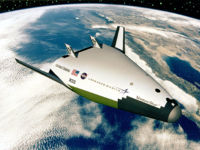PlaneSpottingWorld welcomes all new members! Please gives your ideas at the Terminal.
VentureStar
VentureStar was Lockheed-Martin's proposed design for a single-stage-to-orbit reusable launch system. The program's primary goal was to develop a reusable unmanned space plane for launching satellites into orbit at about 1/10 the cost of other systems that would completely replace the space shuttle. While the requirement was for an unmanned launcher, it was expected to optionally carry passengers as cargo. The Venture Star was hoped to provide rapid turn-around and low cost launches with a modular system. It would have also used a new metallic thermal protection system that would be safer and cheaper to maintain than the ceramic one on the Space Shuttle. It was to be a single stage to orbit vehicle that would take off vertically and land like an airplane. The design specifications also called for it to use Linear aerospike engines, which can provide high efficiency thrust at all altitudes. VentureStar was to be a commercial endeavor and flights would have been leased to NASA as needed.
Failures in the Venture Star's technology demonstrator, the X-33, led to program cancellation on March 1, 2001.
The VentureStar in Fiction
In John Varley's near-future science fiction novel, Red Thunder, the Venture Star is the main spacecraft in use by a United States of America, making daily flights into orbit from Cape Canaveral.
In the opening credits of Star Trek Enterprise, the Venture Star is seen veering away from the International Space Station's docking port.
In the movie Fortress II: Re-entry starring Christopher Lambert, the Venture Star brings supplies to the orbiting prison station and is later hijacked by the prisoners to escape to earth.

